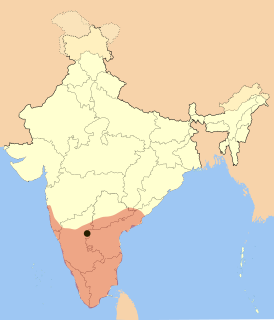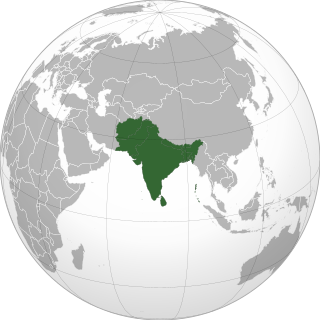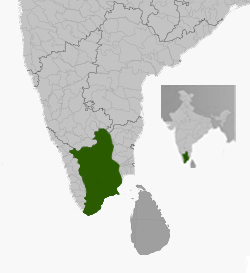Related Research Articles

The Vijayanagara Empire was based in the Deccan Plateau region in South India. It was established in 1336 by the brothers Harihara I and Bukka Raya I of the Sangama dynasty, members of a pastoralist cowherd community that claimed Yadava lineage. The empire rose to prominence as a culmination of attempts by the southern powers to ward off Islamic invasions by the end of the 13th century. At its peak it had subjugated almost all of South India's ruling families and the Sultans of the Deccan region, thus becoming a notable power. It lasted until 1646, although its power declined after a major military defeat in the Battle of Talikota in 1565 by the combined armies of the Deccan sultanates. The empire is named after its capital city of Vijayanagara, whose ruins surround present day Hampi, now a World Heritage Site in Karnataka, India. The writings of medieval European travelers such as Domingo Paes, Fernão Nunes, and Niccolò Da Conti, and the literature in local languages provide crucial information about its history. Archaeological excavations at Vijayanagara have revealed the empire's power and wealth.

The history of southern India covers a span of over four thousand years during which the region saw the rise and fall of a number of dynasties and empires. The period of known history of the region begins with the Iron Age period until the 15th century CE. Dynasties of Chera, Chola, Pandyan, Chalukya, Pallava, Satavahana Rashtrakuta, Kakatiya, Reddy dynasty, Seuna (Yadava) dynasty and Hoysala were at their peak during various periods of history. These Dynasties constantly fought amongst each other and against external forces when northern armies invaded southern India. Vijayanagara empire rose in response to the Muslim intervention and covered the most of southern India and acted as a bulwark against Mughal expansion into the south. When the European powers arrived during the 16th and 18th century CE, the southern kingdoms, most notably Tipu Sultan's Kingdom of Mysore, resisted the new threats, and many parts eventually succumbed to British occupation. The British created the Madras Presidency which acted as an administrative centre for the rest of South India, with them being princely states. After Indian independence South India was linguistically divided into the states of Tamil Nadu, Andhra Pradesh, Karnataka, Telangana and Kerala.

Krishna Devaraya was the emperor of the Vijayanagara Empire during 1509–1529. He was the third ruler of the Tuluva Dynasty and is considered to be its greatest ruler. He possessed the largest empire in India after the decline of the Delhi Sultanate. Presiding over the empire at its zenith, he is regarded as an icon by many Indians. Krishnadevaraya earned the titles Kannada Rajya Rama Ramana, Andhra Bhoja and Mooru Rayara Ganda. He became the dominant ruler of the peninsula of India by defeating the Sultans of Bijapur, Golconda, the Bahmani Sultanate and the Gajapatis of Odisha, and was one of the most powerful Hindu rulers in India. Indeed, when the Mughal Emperor Babur was taking stock of the potentates of north India, Krishnadevaraya was rated the most powerful and had the most extensive empire in the subcontinent.

Achyuta Deva Raya was a ruler of a Vijayanagara Empire of South India. He was the younger brother of Krishna Deva Raya, whom he succeeded in 1529.
Rama Raya, known as "Aliya" was a statesman of the Vijayanagara Empire, the son-in-law of Emperor Krishna Deva Raya and the progenitor of the Aravidu dynasty of Vijayanagar Empire, the fourth and last dynasty of the empire.
Ramarajabhushanudu was a Telugu poet and a notable musician. He was one of the Astadiggajas (a collective title for Telugu poets in the court of Krishnadevaraya of the Vijayanagara Empire.

The Thanjavur Nayak kingdom or Thanjavur Nayak dynasty were the Telugu rulers of Thanjavur principality of Tamil Nadu in the 16th and 17th centuries. The Nayaks of the Balija social group, were originally appointed as provincial governors by the Vijayanagara Emperor in the 15th century, who divided the Tamil country into three Nayakships viz., Madurai, Tanjore and Gingee. In the mid 16th century they became an independent kingdom, although they continued their alliance with the Vijayanagara Empire. The Thanjavur Nayaks were notable for their patronage of literature and the arts.
The Aravidu Dynasty was the fourth and last Hindu dynasty which ruled Vijayanagara Empire in South India. Its founder was Tirumala Deva Raya, whose brother Rama Raya had been the masterful regent of the last ruler of the previous dynasty. Rama Raya's death at the Battle of Rakasa-Tangadi in 1565 led to the subsequent destruction of Vijayanagar by the combined forces of the Muslim states of the Deccan.
Sadasiva Raya (1543–1567) was a ruler of the Vijayanagara Empire, a powerful South Indian empire based in the Deccan in 16th century India.
Sriranga III was the last ruler of the Vijayanagara Empire, who came to power in 1642 following the death of his uncle Venkata III. He was also a great grandson of Aliya Rama Raya.
Venkatapati Raya was the younger brother of Sriranga Deva Raya and the ruler of Vijayanagara Empire with bases in Penukonda, Chandragiri and Vellore. His reign of three decades saw a revival of the strength and prosperity of the empire. He dealt successfully with the Deccan sultans of Bijapur and Golkonda, the internal disorders, promoting economic revival in the country. He brought rebelling Nayakas of Tamil Nadu and parts of present-day Andhra Pradesh under control.

Venkata III was the grandson of Aliya Rama Raya. Venkata III belonged to the Telugu Family and became the King of Vijayanagara Empire from 1632–1642. His brothers in law were Damarla Venkatappa Nayaka and Damarla Ayyappa Nayaka, both sons of Damarla Chennapa Nayakadu

The Madurai Nayaks were Tamilized rulers of Telugu origin from around 1529 until 1736, of a region comprising most of modern-day Tamil Nadu, India, with Madurai as their capital. The Nayak reign was an era noted for its achievement in arts, cultural and administrative reforms, revitalization of temples previously ransacked by the Delhi Sultans, and inauguration of a unique architectural style.
Events from the year 1565 in India.

Tenali Ramakrishna is a 1956 Indian Telugu-language political drama film produced and directed by B. S. Ranga based on Ch. Venkataramaiah's stage play of the same name. Produced for the banner Vikram Productions, it stars Akkineni Nageswara Rao, N. T. Rama Rao, V. Nagaiah, Bhanumathi Ramakrishna and Jamuna in key roles. Ranga handled the cinematography with his brother-in-law B. N. Haridas while P. G. Mohan edited the film. Viswanathan–Ramamoorthy composed the soundtrack and background score.
Navabrundaavana is located at Anegundi, near Hampi, Karnataka, India. It contains the Brundaavanas of nine Hindu Madhva saints, who belong to the Sri Uttaradi Math, Sri Raghavendra Math, Sri Vyasaraja Math and the Sri SriPadaraja mutt and Other Various Prominent Madhwa Mutts. It is located on an island in the Tungabhadra River. The nine saints are
- Shri Padmanabha Tirtha, direct disciple of Jagadguru Shri Madhvacharya
- Shri Kavindra Tirtha
- Shri Vagisha Tirtha
- Shri Raghuvarya Tirtha
- Shri Vyasatirtha
- Shri Sudhindra Tirtha,Guru of Mantralaya Shri Raghavendra Tirtha
- Shri Srinivaasa Tirtha
- Shri Raama Tirtha
- Shri Govinda Vodeyaru
Venkata I was a ruler of a Vijayanagara Empire of South India. He was the younger son of Achyuta Deva Raya from Bheeshanamba Devi, whom he succeeded in 1542.
Maha Mandalaswara Birud-antembara-ganda Hiriya Bettada Vijaya Chamaraja Wodeyar III was fifth raja of the Kingdom of Mysore and the last one to rule as feudal king under the Vijayanagara Empire. He reigned after his father's demise in 1513 until his death in 1553.
Tirumala Devi was the senior wife and chief queen of Emperor Krishnadevaraya, who is considered to be the greatest ruler of the Vijayanagara Empire. She was also the most honoured wife of Krishnadevaraya, and the mother of his heir-apparent, Prince Tirumala, who died in his childhood.